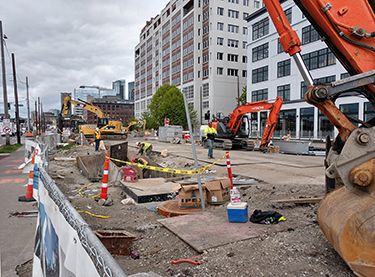|
Subscribe / Renew |
|
|
Contact Us |
|
| ► Subscribe to our Free Weekly Newsletter | |
| home | Welcome, sign in or click here to subscribe. | login |
Construction
| |
April 22, 2020
Construction industry has a 3-prong plan to restart
Journal Construction Editor
A construction advisory group developing a three-phase plan to safely resume construction statewide has sent its initial recommendation to Gov. Jay Inslee.
There's been a lot of talk since Inslee issued the stay-at-home order on March 23 about which construction projects are “essential” and can continue without interruption. Inslee's stay-at-home order was extended a month to May 4, and could be extended again.
In Seattle, Gary Merlino Construction is continuing its work along the waterfront while projects such as Martin Selig's expansion and renovation of the Federal Reserve Bank building on Second Avenue downtown remains shut down, with general contractor Lease Crutcher Lewis off the job.
The advisory group consists of the Associated General Contractors of Washington, Building Industry Association of Washington, Association of Washington Business and three labor groups: Washington Building Trades and the Operating Engineers' and Carpenters' unions.
“It's a collaboration between labor and management where every decision has been unanimous,” said AGC of Washington Executive Vice President David D'Hondt.
In an April 17 email to members, D'Hondt wrote that the bulk of the first-phase projects could include some commercial, residential and road building jobs that were already started. These are “low-risk” projects where social distancing — 6 feet of space — can be maintained.
The group also agreed upon a four-page phase one restart proposal that outlines additional safety measures. This includes requiring all contractors to develop and post a comprehensive COVID-19 exposure control, mitigation and recovery plan at each jobsite.
Those jobsite postings must include policies on personal protective equipment use, social distancing, hygiene, sanitation, symptom monitoring, incident reporting, site decontamination procedures, COVID-19 safety training, exposure response procedures and a post-exposure incident project-wide recovery plan.
Here are some specifics under the phase one plan:
• Every jobsite must have a COVID-19 supervisor present at all times to monitor the health of employees and enforce the COVID-19 safety plan. An exception is single-family home sites where there are fewer than seven people.
• Safety stand-down/toolbox talk/tailgate training must be conducted on all jobsites on the first day of returning to work and weekly after that.
• A daily attendance log of all workers and visitors must be retained for at least four weeks.
• Social distancing must be maintained.
• “Choke points” and “high-risk areas” on jobsites where workers typically congregate must be controlled.
• Minimized interactions when picking up or delivering equipment or materials.
• If practical, allow only one trade/subcontractor at a time on a jobsite.
• Workers must wear gloves, goggles, face shields and face masks as appropriate.
• Provide soap and running water to wash hands; or portable wash stations.
• Frequent cleaning of high-touch surfaces on jobsites and in offices, such as shared tools, machines, vehicles and other equipment, handrails, doorknobs and portable toilets.
• Send sick employees home and disinfect the area where that person worked.
• Workers coming from noncontiguous states to Washington must self-quarantine for 14 days before working.
Failure to comply with these requirements will shut down the jobsite.
The second phase of projects include new and existing jobs that have tasks that can't meet social distancing requirements.
D'Hondt said the Division of Occupational Safety & Health of the state Department of Labor & Industries was expected to decide by Friday what type of personal protective equipment could be worn when working within 6 feet of another person. He said his group will submit its phase two recommendations after DOSH makes that ruling.
Third-phase projects involve those with more technical issues, such as skyscrapers where workers have to crowd onto elevators and may not have access to hand-washing stations on every floor.
Inslee had scheduled a press conference last night after the DJC news deadline to update the state's COVID-19 recovery plan. It was unknown if he was going to address the concerns of the construction community.
Benjamin Minnick can be
reached by email or by phone
at (206) 622-8272.



